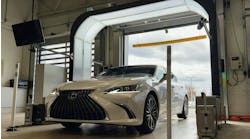If you pay attention to social media in any page or group related to automotive repair, you’ve likely seen multiple “oops” videos or photos of vehicles that have fallen off lifts. They’re often with shop personnel surveying the scene, trying to determine what went wrong, but your shop doesn’t have to be the next one to “go viral” – or suffer the tragedy of a serious injury or death that could have been prevented.
“The leading cause of a vehicle falling off a lift is operator error,” said R.W. “Bob” O’Gorman, president of the Automotive Lift Institute (ALI), which last year celebrated 75 years as the “lift industry safety watchdog” to test and certify lifts, and more than 30 years of training millions of lift operators the correct way to use car lifts through its Lifting it Right program, originally a manual and now updated and available as an interactive online course, as well as a new-in-20202 Lifting it Right: School Edition, for high schools, trade schools and technical schools, available exclusively through SP/2.
“It is crucial that all technicians be properly trained on how to operate the lifts they trust with their lives,” he said. “It is also very important not to take shortcuts when it comes to lift safety.”
According to the ALI website, the ALI course, available by either one-time use or an annual subscription, is designed to show the correct way to lift a vehicle “without causing injury or property damage. It provides guidance on spotting and lifting a vehicle, as well as preparing the service bay, maintaining load stability, lowering the lift and lift maintenance. It is a good overview and supplement to training on your specific lift.”
Although the scope of this article does not allow for in-depth detail of all details of proper lift operation, O’Gorman gave examples of some common mistakes technicians make when using a two-post lift:
- Not spotting vehicles properly
- Miscalculating the center of gravity
- Overloading the lift
- Not using the right adapters
- Leaving the lift controls while the lift is in motion
“All ALI Certified two-post lifts are hold-to-run with a raise button, lowering valve and load-holding latch release,” O’Gorman said. “This design is to ensure that the technician stands at the lift the entire time the vehicle is being raised and lowered so he or she can quickly respond to any issues.”
As O’Gorman pointed out, technicians have been known to override these systems, by, as an example, tying open the lowering valve, so they can walk away and do something else while the vehicle is being lowered.
“That means they’re not able to stop the lift if they forgot to remove equipment from under the vehicle, which could lead to the equipment being crushed or even pushing the vehicle off the lift.”
David Willett, value creation executive at ProSight Specialty Insurance, said in addition to regularly scheduled professional inspections, shop operators should check for proper operation of these safety latches and locks.
The technician using the lift bears some responsibility for his or her own safety, too, and Willett noted management should be notified immediately of any unusual noises, hydraulic leaks, or erratic operation.
Where to place the lift arms
Sometimes technicians rely on their experience to guess where to position the lift arms, which is a big mistake, O’Gorman said. They instead should use the lifting points recommended by the vehicle manufacturer.
“If you’re unsure what those points are, you can check our annual quick reference guide Lifting Points for Frame-Engaging Lifts, the vehicle shop manual, or the vehicle undercarriage itself,” he said. “Trying to lift the vehicle by positioning the adapters at other points may damage the vehicle or cause instability.”
Likewise, technicians should always check the condition of the surfaces of the lifting points for damage, rust, oil, or anything else that could cause slippage.
“You’ll need the right adapters to reach the manufacturer’s recommended lifting points. Always check the adapters for excessive wear or other issues before use. Never use homemade adapters, such as blocks of wood.”
Electric vehicle precautions
As more battery electric vehicles make their way to shops, their batteries, which are under the floorpan, may interfere with placement of many two-post swing-arms.
“As with any vehicle, it is very important to follow the electric vehicle manufacturer’s lifting and service recommendations,” O’Gorman said. “If in doubt, or if the two-post lift you have isn’t equipped to reach the manufacturer’s recommended lifting points, use a drive-on lift like a four-post model instead.”
Anyone who is using a vehicle lift must be trained in the proper operation of the lift, including how to properly spot and lift the vehicle in accordance with OEM guidelines.
When removing major components, such as an engine or transmission, that may cause a radical shift in center of gravity, the technician should use high-reach or supplementary stands to stabilize and equalize the load, O’Gorman pointed out. The total capacity of the stands should equal or exceed the load applied by the vehicle; for example, if lifting a vehicle that weighs 7,000 lbs., the stands should have a total load capacity of at least 7,000 lbs. “Never use auxiliary stands, engine stands or transmission jacks in place of high-reach fixed or high-reach, supplementary stands,” he cautioned.
O’Gorman said ALI recommends using high-reach supplementary stands that are certified to the Portable Automotive Service Equipment standard (ANSI/ASME PASE-2019 Standard Safety Standard for Portable Automotive Service Equipment) when removing components or working below the point where the load-holding device engages.
“Rather than guessing if it is suitable to use one or two supplementary stands and risking an unbalanced load (front to rear or side to side), the use of four such stands, as depicted in ALI’s safety materials, is recommended.”
Lift certifications
Not all lifts available in the marketplace are ALI-certified, and not all lifts submitted for ALI certification pass testing. (A list of certified lifts can be found here: www.autolift.org/ali-directory-of-certified-car-lifts/) O’Gorman said all automotive lift products evaluated for certification by ALI are first put through a rigorous battery of electrical and mechanical tests by independent, third-party nationally recognized testing laboratories (NRTLs).
“Deficiencies found in lifts that fail to earn ALI’s Gold Certification Label (and therefore the right to bear the ALI mark) can generally be broken down into three areas: quality control, mechanical, and electrical-related non-compliance,” he said.
Quality control deficiencies in many cases, he said, often are because the manufacturer is unfamiliar with known industry practices and safety measures. Examples could include failing to develop and maintain stress calculations, operating without drawings or revision control, or refusing access to production factories for audit purposes.
Mechanical deficiencies typically range from undersized sheaves and cables, to poor welding practices, or even inappropriate raw materials such as substandard steel composition or nuts and bolts.
“Do you really want to source your car or truck lift from a company buying market-grade steel that varies by the day or even the lot purchased?” he said.
Electrical deficiencies, he said, can be summarized as failure to comply with the electrical listing requirements for a product used in North America.
“The required safety standards for this product are clear in both the US and Canadian provinces. The required electrical safety standards are also clear in the International Building Code, the majority of state building codes, and for workplace safety regulators.”
ALI Lift Inspector Certification Program provides qualification of vehicle lift inspectors
The ALI Lift Inspector Certification Program was created to provide third-party qualification of vehicle lift inspectors. It certifies “those who demonstrate that they are capable of properly inspecting any type of lift from any manufacturer in accordance with the ANSI standard governing vehicle lift inspection and in support of OSHA’s General Duty Clause, as well as provincial requirements in Canada,” according to the website. (A directory of certified lift inspectors can be found here: www.autolift.org/find-a-certified-auto-lift-inspector.) Inspections are not limited to ALI-certified lifts.
Inspectors must have a minimum of 12 months of related experience. Participants receive extensive technical information and documentation of the proper methods to evaluate an automotive lift. To obtain certification, participants must attend a six-hour orientation workshop, pass a pre-course and final course exam, and properly complete 12 practical lift inspections on a range of vehicle lifts. According to ALI, its program is the “first in North America to independently test and certify individuals as qualified to inspect any vehicle lift and determine if it is suitable for continued use.”




